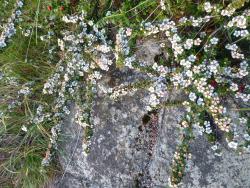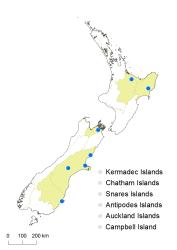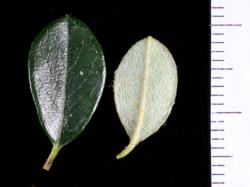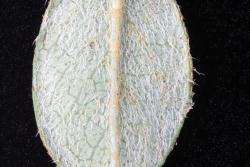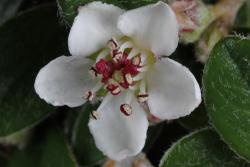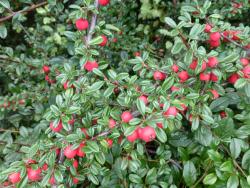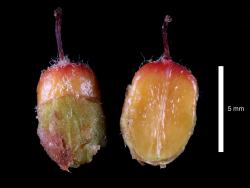- ≡ Crataegus integrifolius Roxb., Fl. Ind. (Roxburgh) 2, 509 (1832)
- = Cotoneaster conspicuus Comber ex C.Marquand, Bull. Misc. Inform. Kew 1937: 119 (1937)
Prostrate shrub 0.8–2.0 m tall, evergreen. Branches flattened planes; branchlets red-brown, peeling cuticle present, branchlet hairs moderately dense to dense; stipule 1.4–2.3 mm long, red or green, stipule hairs sparse to dense, white to yellow. Leaves crowded on branches, 12–25(26) mm long, lamina 10–18(21) mm long, 4.5–10 mm wide, elliptical to obovate, slightly V-shaped, 250–340 µm thick, petiole 1–2.5 mm long, petiole hairs dense, yellow; leaf base cuneate; leaf apex acute to obtuse appearing emarginate, apiculus bent downwards; lateral veins in 1–5 pairs or none visible, midvein only impressed above and projecting below; upper surface smooth, dark green (RHS 136A), semi-glossy, upper surface hairs sparse to moderately dense, white, persistent; margins recurved, hairs moderately dense to dense, yellow or white; lower surface glaucous, hairs moderately dense, white, fine, straight.
Flowers solitary, on a branch 8–10 mm long with 3–6 leaves, pedicel 1.5–3.5 mm long, hairs dense, yellow. Flowers c. 10 mm diameter. Hypanthium green, red at sepal margins and becoming red after flowering, sepals 1.0–1.5 mm long, 2.0–2.2 mm wide, hairs moderately dense, white. Petals pink in bud, white and spreading when open, 4.2–4.3 mm long, 3.8–4.5 mm wide, base clawed, glabrous, margins entire, minutely papillose. Stamens 15–19; filaments 2.5–2.8 mm long, white; anthers red-purple, 0.6–1.0 mm long; styles 2, 2.0–3.6 mm long. Fruit not glossy, slightly white pruinose, vivid to strong red (RHS 44A–46A), obovoid, 7.0–9.0 mm long, 7.4–10.0 mm diameter, calyx closed, an even spread of white appressed hairs that rub off the fruit. Pyrenes invariably 2, 4.1–5.8 mm long, 3.1–4.0 mm wide, hairs absent to moderately dense at apex, style attached at pyrene apex.
Internationally there is a considerable difference of opinion over Cotoneaster integrifolius, C. microphyllus and its varieties, and C. conspicuus. In addition, both in New Zealand and in other countries they have been misidentified. Lu & Brach (2003) and Dickoré & Kasperek (2010) argue that C. integrifolius is a diploid montane to subalpine species in the wild, and that C. conspicuus is a synonym of C. integrifolius, while C. microphyllus is a tetraploid alpine species. Fryer & Hylmö (2009) recognise all three species, and recognise several species within the C. microphyllus species complex such as C. glacialis and C. thymifolius. According to Fryer & Hylmö (2009), C. microphyllus is tetraploid, C. thymifolius and C. conspicuus are diploid, and C. integrifolius is tetraploid.
The approach taken here is to recognise three species as being in New Zealand: C. integrifolius, C. microphyllus, and C. thymifolius. Cotoneaster integrifolius in New Zealand is diploid, triploid, and tetraploid. This is consistent with the view of Fryer & Hylmö (2009) that there is more than one species within C. integrifolius sens. lat., but they do not list any triploid species within the series Conspicui G.Klotz. The diploid, triploid, and tetraploid plants do not correspond to recognisable entities within the variation in C. integrifolius. A broad species concept for C. integrifolius is used here, following Lu & Brach (2003).
Sub-erect shrub, leaves small (12–25 mm long, 10–18 mm wide), elliptic to obovate, midvein impressed, leaf slightly V-shaped, apex obtuse with an apiculus appearing emarginate due to the apiculus bending downwards. Flowers solitary, petals white and spreading, styles 2, filaments white, anthers red-purple. Fruit vivid red to dark red, obovoid to almost spherical, with hairs evenly spread over the fruit surface but these rubbing off, pyrenes invariably 2 with style attached at the pyrene apex.
Most similar to Cotoneaster microphyllus in prostrate form, narrowly elliptic to obovate leaves with laminae that are somewhat longer than for C. microphyllus (lamina 10–18(21) mm long, cf. 5.3–10.0 mm long in C. microphyllus), flowers solitary, petals pink in bud, white and spreading when open, stamens 15–19, filaments white, anthers red-purple, pyrenes 2 with style attached at apex. Cotoneaster microphyllus differs in having a very glossy upper leaf surface and an apex that appears emarginate due to a strongly recurved apex and strongly grooved midvein. Cotoneaster integrifolius has leaves that are semi-glossy, partly due to an even spread of fine, persistent hairs; the apex is acute to obtuse and sometimes appears emarginate, but not with a strongly grooved midvein.
Similar to Cotoneaster horizontalis but having slightly arching branches, not distichously branched, petals spreading rather than erect, and fruit dark pink, not scarlet as in C. horizontalis. Leaves thicker in texture than C. horizontalis but less V-shaped. The leaves have denser, more strigose hairs on the lower surface, and beneath the hairs the leaf undersurface is clearly glaucous, whereas the leaves of C. horizontalis are not glaucous.
The largest-leaved forms of C. integrifolius have leaves very similar to those of C. ×suecicus. Both are more or less prostrate shrubs but when supported can reach 1–2 m; both have sparse non-planar branching; the leaves overlap slightly in size (at their smallest C. ×suecicus leaves are 24 x 10 mm), the leaf upper surface is glossy, the leaf slightly folded, the margins slightly recurved, the undersurface of the leaf glaucous and moderately densely hairy with straight appressed hairs. The flowers have no obvious differences: petals in both are white, pink in bud, and spreading; filaments are white and anthers red-purple in both. Fruit hairs are evenly spread and persistent in C integrifolius, while hairs are absent from C. ×suecicus fruit. Pyrenes are 2 per fruit in C. integrifolius, usually (2)3–4(5) in C. ×suecicus. Cotoneaster integrifolius has the style attached at the pyrene apex, C. ×suecicus has the style attached slightly below the apex. Pyrene/style number provides the surest way of distinguishing the two, and they can be difficult to distinguish when flowers or fruit are absent. Cotoneaster integrifolius retains fruit for most of the year.
Volcanic Plateau (Lake Rotoiti, 1994), Gisborne (near Eastwoodhill Arboretum, 1989), Nelson (Kaituna R; 1996), Canterbury (Blythe Valley, 2009; Dyers Pass, 1995; Rangitata R, 1985).
Heenan et al. (1998, p. 157) as Cotoneaster conspicuus.
CHR 485661, M.J. Newfield 1/95, 19 Oct. 1995, Port Hills, Dyers Pass.
Flowering: mid October to early December; Fruiting: February to May
Tetraploid (Fryer & Hylmö 2009). Flow cytometry of five New Zealand plants in cultivation shows three ploidy levels: diploid, triploid, and tetraploid (CHR 635042, CHR 635028, CHR 635039, CHR 638090, and CHR 638098)



